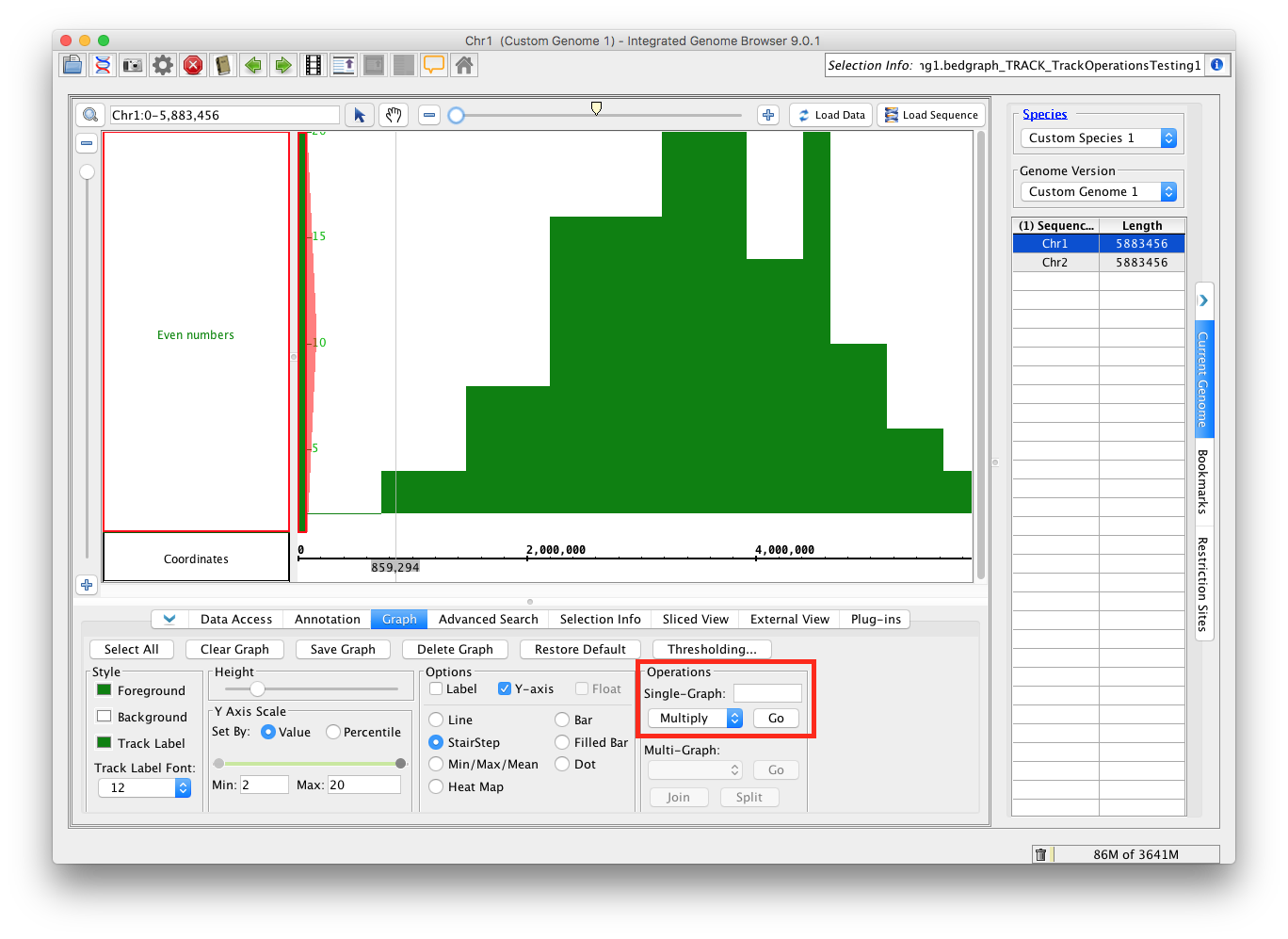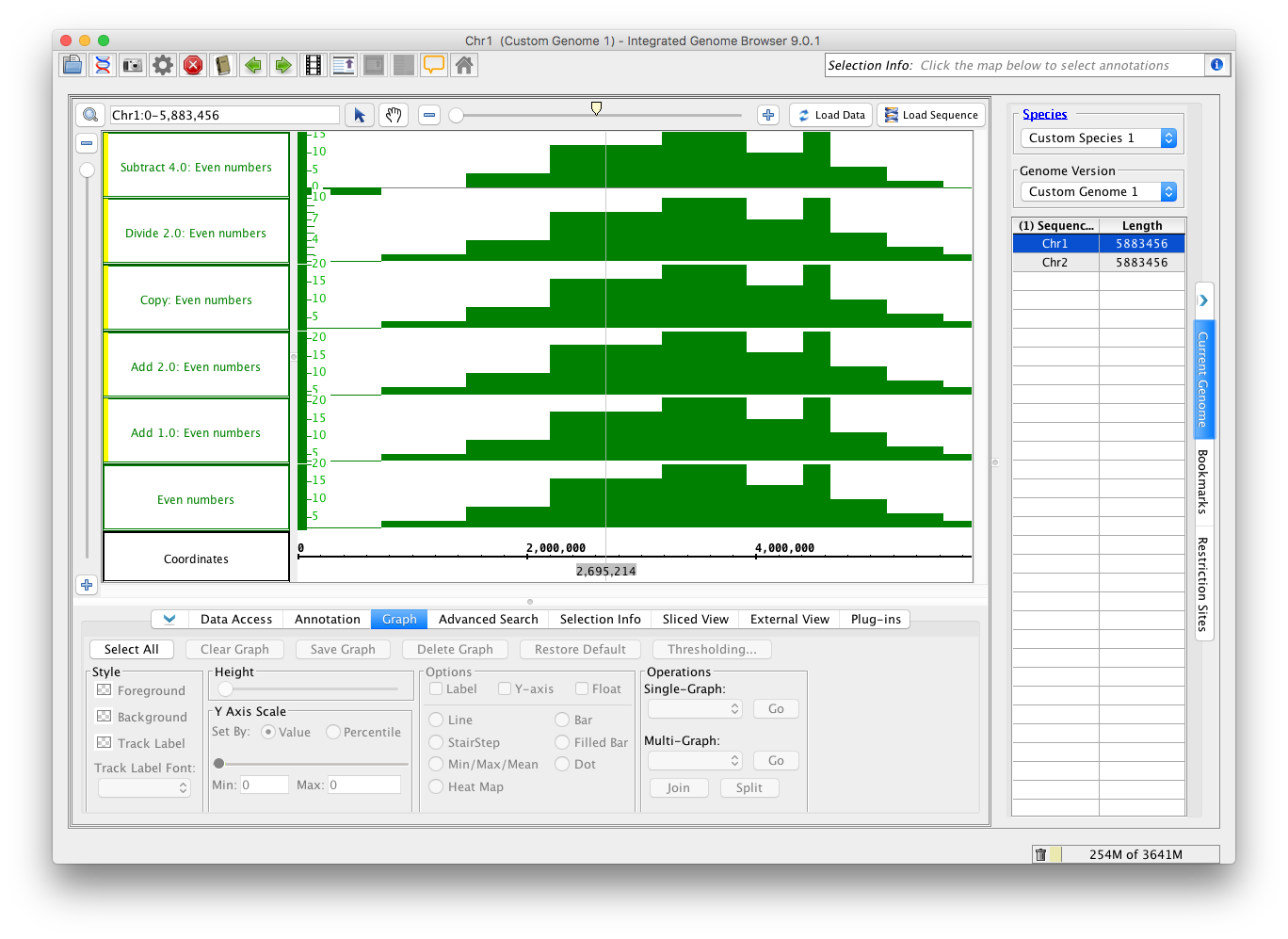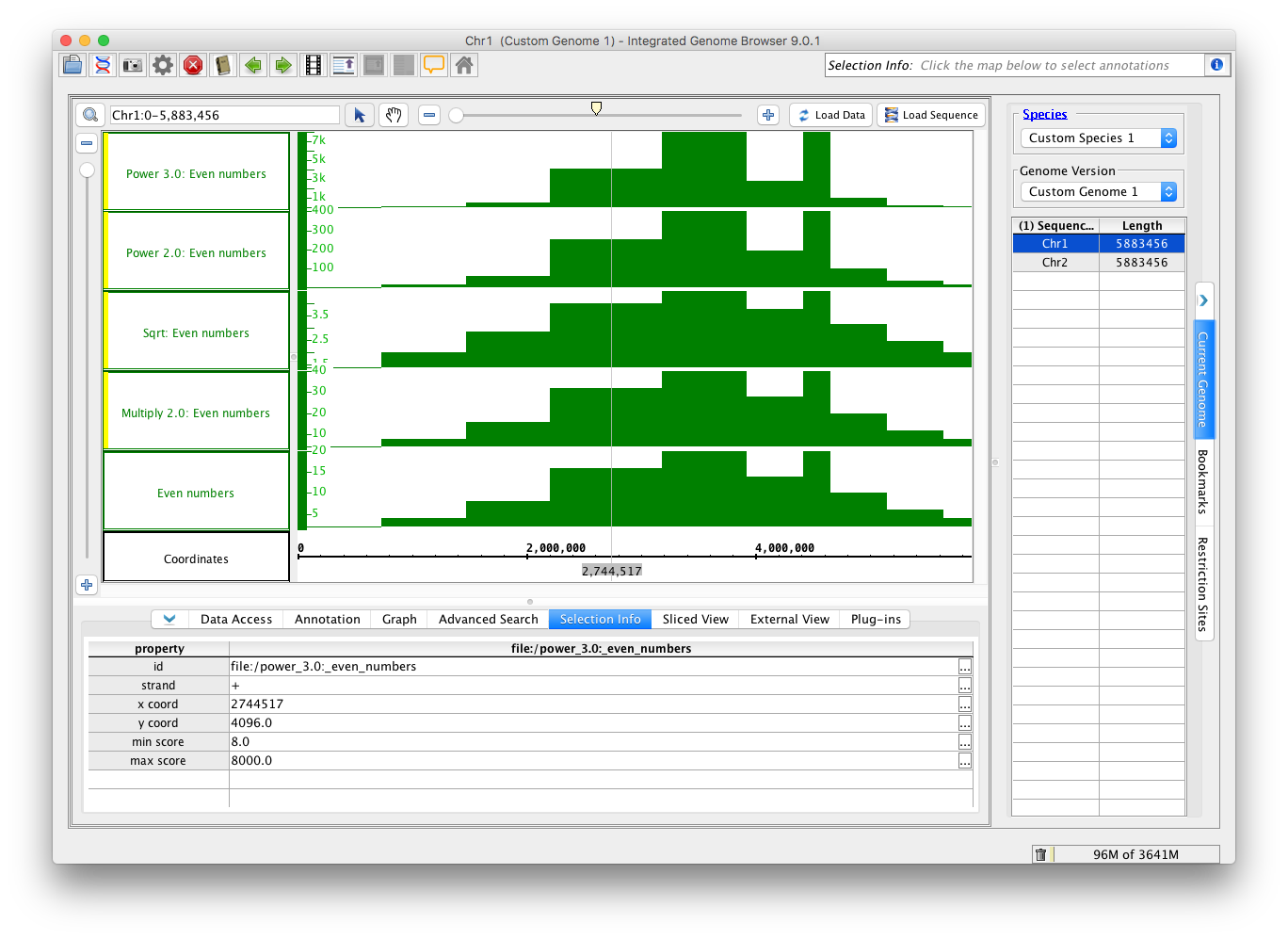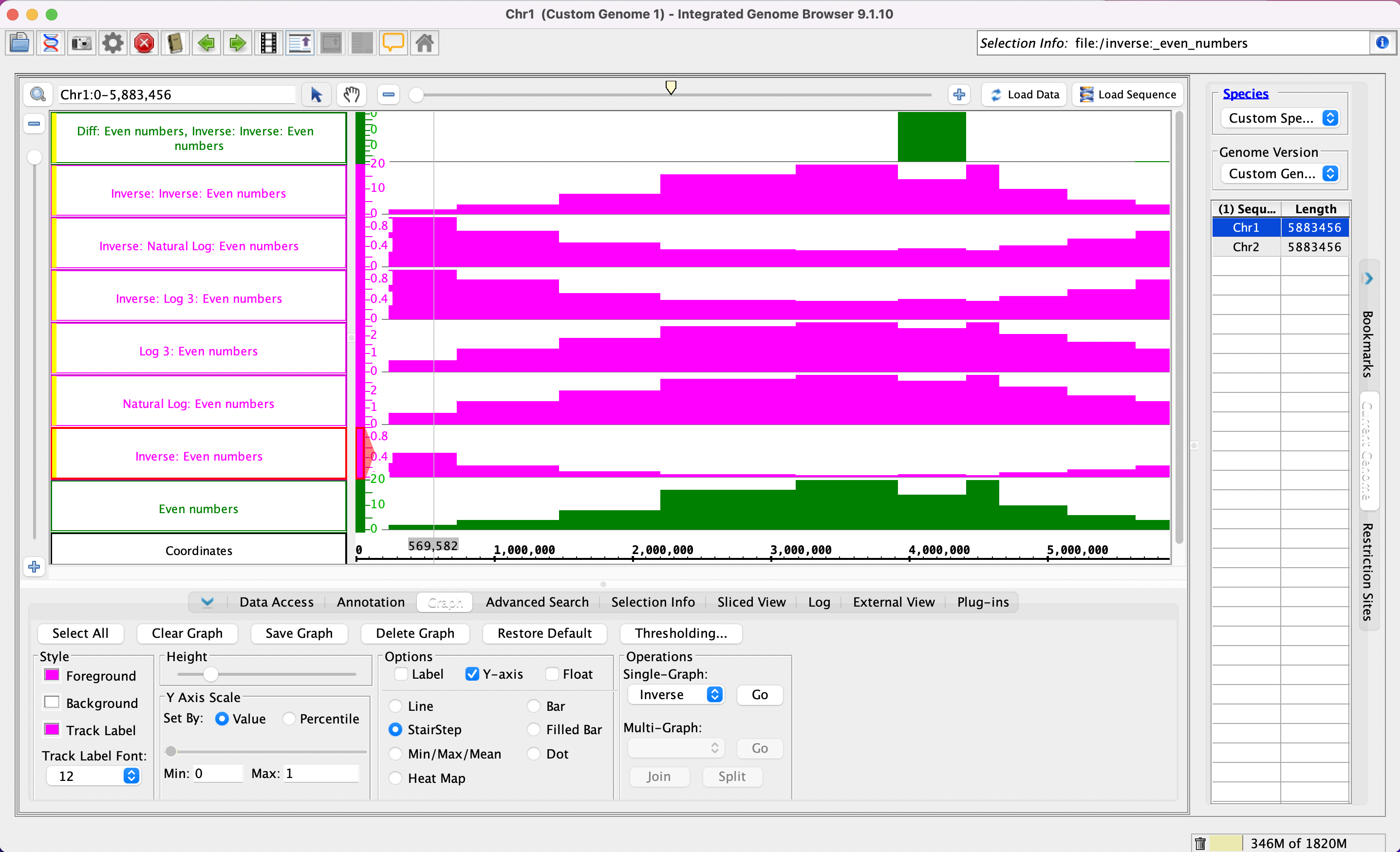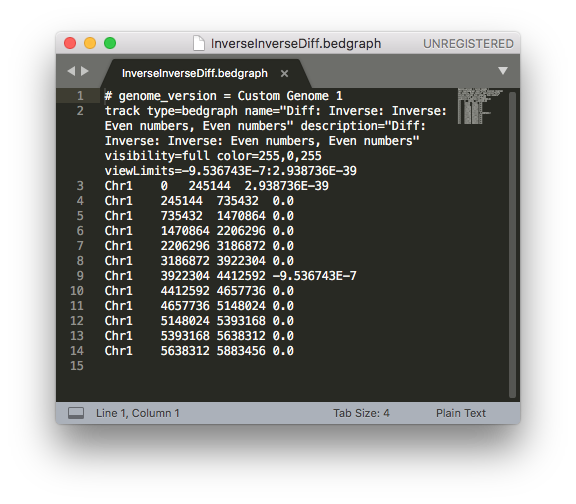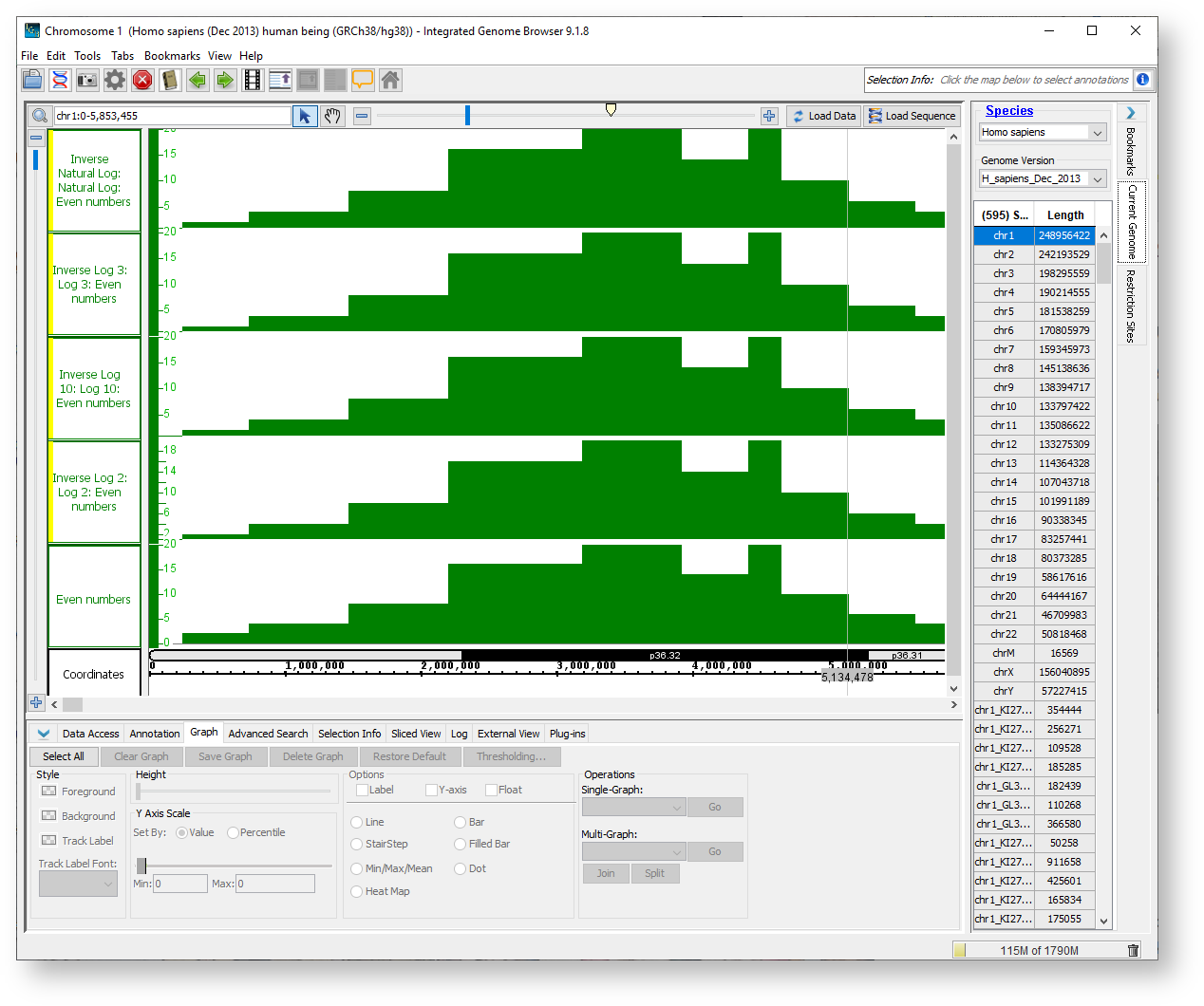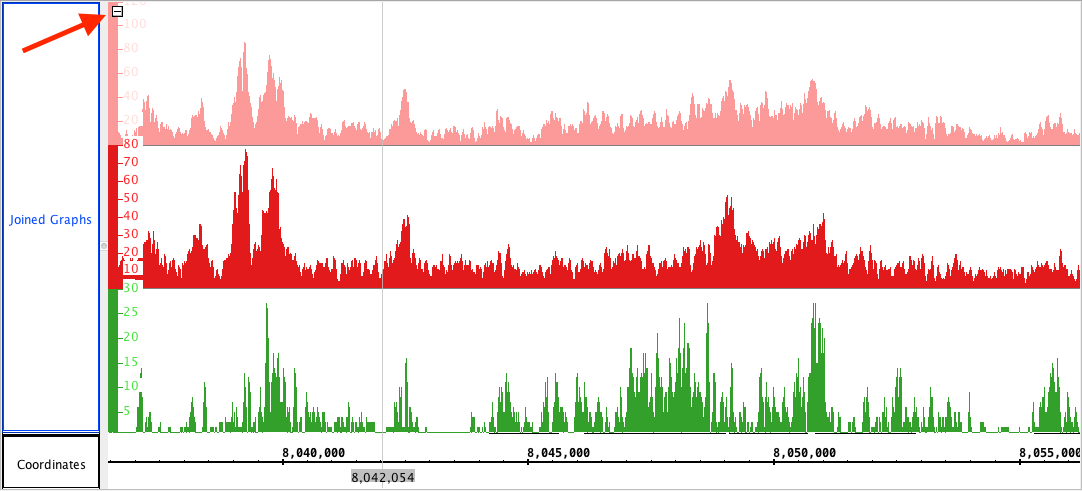General Function Checklist
Graph Track Operators
Note: Be sure to look at the user guide pages linked here. Skim them to make sure that the topics they cover are represent here (if not add points here as needed). Read enough to ensure that the instructions and explanations are clear, and the page has accurate information and generally appears up-to-date.
Add the Even Numbers test file
Get the graph track operations test file. There is probably a copy in the code base in the test sources in the Track Operations module.
You can just paste this into a text file, or download it from here: TrackOperationsTesting1.bedgraph
# genome_version = A_thaliana_Jun_2009
track type=bedgraph name="TrackOperationsTesting1" description="Even numbers" color=0,128,0
Chr1 0 245144 0
Chr1 245144 735432 2
Chr1 735432 1470864 4
Chr1 1470864 2206296 8
Chr1 2206296 3186872 16
Chr1 3186872 3922304 20
Chr1 3922304 4412592 14
Chr1 4412592 4657736 20
Chr1 4657736 5148024 10
Chr1 5148024 5393168 6
Chr1 5393168 5638312 6
Chr1 5638312 5883456 4
Chr2 0 245144 2
Chr2 245144 490288 2
Chr2 490288 735432 2
Chr2 735432 1225720 4
Chr2 1225720 1470864 4
Chr2 1470864 1716008 8
Chr2 1716008 2206296 8
Chr2 2206296 186872 16
Chr2 3186872 3922304 20
Chr2 3922304 4167448 14
Chr2 4167448 4412592 0
Chr2 4412592 4657736 20
Chr2 4657736 4902880 10
Chr2 4902880 5148024 10
Chr2 5148024 5393168 6
Chr2 5393168 5638312 0
Chr2 5638312 5883456 0
- Add the track operations test file to IGB by dragging/dropping the file onto the home screen.
- Change the Load Mode to Genome.
- In the Graph panel at the bottom of IGB, under Options, select StairStep.
You may need to adjust the y-axis scale for each graph track.
Single Track Operations - part 1 - add and subtract
- Click on the Even numbers track.
- In the Graph panel at the bottom of IGB, under Operations, under Single-Graph, select Add.
- There is a box next to Single-Graph that you can add values to.
- mac
- linux
- windows
Enter 1 in the box next to Single-Graph and hit Go.
- A new track was created with yellow highlight around the track label.
- mac
- linux
- windows
Enter 2 in the box next to Single-Graph and hit Go.
- Another new track was created with yellow highlight around the track label.
- mac
- linux
- windows
- Select Copy, and hit Go.
- Select Divide, enter 2, hit Go.
- Select Subtract, enter 4, hit Go.
- Click Select All.
- Select StairStep.
- Adjust the width of the label box so you can see the full label for each track.
- Your IGB looks like the image above.
- mac
- linux
- windows
- All of the tracks you've created have a yellow highlight in the label box.
- mac
- linux
- windows
- All of the tracks have appropriate names, which include the function, any values you added, and the name of the original track.
- mac
- linux
- windows
- All of the graphs are shaped like the original, (subtract may look a little different because the relative position of zero has changed.
- mac
- linux
- windows
- Click in the original track in the region that has the value 16 (see the zoom stripe in the image above).
- Go to the Selection Information panel.
- Click the same area in each of the tracks that you created and verify that their values are as follows:
- Add 1 = 17
- Add 2 = 18
- Copy = 16
- Divide by 2 = 8
- Subtract 4 = 12
- mac
- linux
- windows
Go to the Data Access panel and remove each of the tracks you created.
Single Track Operations - part 2 - powers
- Go to the Graph panel, and select the Even Numbers track.
- Select Multiply, enter 2, and hit Go.
- Select Sqrt, hit Go.
- Select Power, enter 2, and hit Go.
- Select Power, enter 3, and hit Go.
- Use the Select All button (upper left of Graph panel) to select all of these tracks.
- Select StairStep.
- Adjust the width of the label box so you can see the full label for each track.
- Your IGB looks like the image above.
- mac
- linux
- windows
- All of the tracks you've created have a yellow highlight in the label box.
- mac
- linux
- windows
- All of the tracks have appropriate names, which include the function, any values you added, and the name of the original track.
- mac
- linux
- windows
- All of the graphs are shaped like they are in the above image.
- mac
- linux
- windows
- Go to the Selection Information panel.
- Click the same area in each of the tracks that you created and verify that their values are as follows:
- Multiply by 2 = 32
- Sqrt = 4
- Power 2: = 256
- Power 3 = 4,096
- mac
- linux
- windows
- Go to the Data Access panel and remove each of the tracks you created.
- Return to the Graph panel, and select the Even Numbers track.
Single Track Operations - part 3 - log and inverse
- Go to the Graph panel and select the Even Numbers track.
- Select Inverse, hit Go.
- Select Natural Log, hit Go.
- Select Log, enter 3, hit Go.
- Select all three of these tracks by holding the shift key and clicking on each.
- With all three selected, do the following:
- Change the foreground (FG) color to pink.
- Select the Inverse single graph operation, then hit Go.
- Three new pink tracks were created.
- mac
- linux
- windows
- Select the Even Numbers track and the Inverse: Inverse: Even Numbers track.
- Select the Multi-Graph operation Diff, then hit Go.
- Select all tracks and choose StairStep.
- Deselect all tracks.
- Select:
- Inverse: Natural Log: Even Numbers
- Inverse: Log 3: Even Numbers
- Inverse: Even Numbers
- In the Graph panel, set the Y Axis Scale to:
- Min: 0
- Max: 1
- Deselect all. (See that the tracks make hills and valleys. The inverse tracks show the opposite trends as the non-inverse or double-inverse tracks.)
- Select the track called Diff Even Numbers, Inverse: Inverse: Even Numbers.
- Right click the track label.
- Choose Save Track As...
- Save the track with the following name: InverseInverseDiff
- Open this file, and see that all values are 0 (or trivially far from 0).
- The Diff Inverse Inverse track has all 0-values. Notice that the top and bottom of the y-axis for this track in the image above are 0.
- mac
- linux
- windows
- The shapes and names of tracks corresponds to the image above.
- mac
- linux
- windows
Single Track Operations - part 4 - inverse logs
- Go to the Graph panel and select the Even Numbers track.
- Select Log 2, hit Go.
- Select Log 10, hit Go.
- Select Log, enter 3, hit Go.
- Select Natural Log, hit Go.
- Select the Log 2: Even Numbers track, select the Inverse Log 2 operation, hit Go.
- Delete the Log2: Even Numbers track.
- Select the Log 10: Even Numbers track, select the Inverse Log 10 operation, hit Go.
- Delete the Log 10: Even Numbers track.
- Select the Log 3: Even Numbers track, select the Inverse Log operation, enter 3, hit Go.
- Delete the Log 3: Even Numbers track.
- Select the Natural Log: Even Numbers track, select the Inverse Natural Log operation, hit Go.
- Delete the Natural Log: Even Numbers track.
- Set all created tracks to StairStep.
- All of the created tracks look identical to the even number track (as illustrated in the picture above).
- Mac
- Windows
- Linux
Go to the Data Access panel and remove each of the tracks you created.
Saving a Track
- Add the track operations test file. You can do this without selecting any genome, just drag/drop the file onto the home screen.
- Change the Load Mode to Genome.
- Select the Even Numbers track. In the Graph panel, under Operations, under Single-Graph, select Add, and enter 1.
- Select all graph tracks and set them to StairStep.
- Go to the Data Access panel.
- The new track is called "Add 1.0: Even Numbers".
- Mac
- Windows
- Linux
- Change the Track Name to Odd Numbers.
- Change the foreground color (FG) to light blue.
- Right click on the Odd Numbers track label area and click Save Track As...
- Save the file as TrackOperationsTest2, keep the bedgraph file type.
- Add this file (the one you just created) to IGB.
- Click load data, and set it to StairStep.
- The track read from the saved file is completely identical to the track it was made from (same color, name, values).
- Mac
- Windows
- Linux
Remove the track with the yellow highlight. The two TrackOperationsTest files are what you will use to test the Multi-Track Operations.
Multi-Track Operations
Note: You should have two tracks, one with all even numbers and one with all odd. If not, see section Saving a Track.
- Select the Odd Numbers track, hold shift and select the Even Numbers track (be sure to select the blue odd numbers first).
- In the Graph panel, under Operations, under Multi-Graph, select the first option, and hit Go.
- Select the second option and hit Go.
- Do this for each operation, and then verify the following points. (The values for each operation are given for the range that is 16 in the original Even Numbers file.)
- Even Numbers: 16
- Odd Numbers: 17
- Sum: Odd Numbers, Even numbers: 33
- Diff: Odd Numbers, Even numbers: 1
- Product: Odd Numbers, Even numbers: 272
- Ratio: Odd Numbers, Even numbers: 1.0625
- Mean: Odd Numbers, Even numbers: 16.5
- Median: Odd Numbers, Even numbers: 16.5
- Max: Odd Numbers, Even numbers: 17
- Min: Odd Numbers, Even numbers: 16
- All values in your IGB session match the expected values defined above.
- Mac
- Windows
- Linux
- All track names include both input track names in the order they were selected.
- Mac
- Windows
- Linux
- For some operations, the order matters. So, now select the Even Numbers track first, hold shift, and select the Odd Numbers track. Produce the same tracks as above to verify the following:
- Even Numbers: 16
- Odd Numbers: 17
- Diff: Even Numbers, Odd Numbers: -1
- Ratio: Even Numbers, Odd Numbers: 0.94117647
- All values in your IGB session match the expected values defined above.
- Mac
- Windows
- Linux
- All track names include both input track names in the order they were selected.
- Mac
- Windows
- Linux
Joining and Splitting graphs
- Open the A_thaliana_Jun_2009 genome.
- In the Data Access panel, find Chip-Seq / ARR10 PRJNA263839 / graphs
- Select:
- the first one (line a1 BA-treated ChIP rep1 coverage)
- the second one (line a1 BA-treated non-IP rep1 coverage)
- the seventh one (line a2 non-BA-treated ChIP coverage)
- Navigate to: Chr1:8,036,457-8,056,240
- Click Load Data.
- Arrange them so the green one is on top, then the pink, then the red.
- Select them in this order: pink, red, green.
- In the Graph panel, select Join.
- The three tracks now share a single label field called Joined Graphs.
- Mac
- Windows
- Linux
- The three tracks are ordered top to bottom: pink, red, green (i.e., the order of selection).
- Mac
- Windows
- Linux
Click the little minus button [-] in the upper left corner of the joined tracks.
- Pink is the most visible (it's in front), red is the next most visible, and green is in the back (see image above).
- Mac
- Windows
- Linux
Click the + button to expand them.
- The top-to-bottom order unchanged.
- Mac
- Windows
- Linux
Click the shared label area. In the Graph panel, select Split.
- All tracks are separate again.
- Mac
- Windows
- Linux
Repeat the above steps using a different selection order.
- The order is consistently reflected in how the tracks are stacked together.
- Mac
- Windows
- Linux
To mimic the images exactly (optional):
- Go to this region: Chr1:8,036,457-8,056,240
- In the Graph panel, Select All graphs, click the Height knob (no need to actually slide it).
- Select the red track and set the Max to 80.
- Select the green track only and set the Max to 30.
- Select the pink track and set the Max to 120.
Users Guide
Review the relevant Users Guide pages.
Each page has accurate information and generally appears up-to-date.
- Mac
- Windows
- Linux
